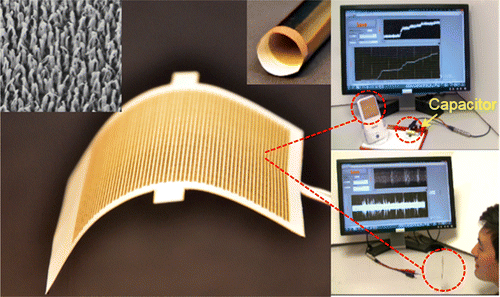Credit: ACS Nano
Six authors have described their work in harvesting energy in a paper titled "Ultrathin, Rollable, Paper-Based Triboelectric Nanogenerator for Acoustic Energy Harvesting and Self-Powered Sound Recording." Translation: A paper microphone may help charge your cellphone. Jacob Aron in New Scientist wrote about their work; he said one benefit of such a microphone is that it could harvest acoustic energy to top up a phone charge on the go. The team, from the Georgia Institute of Technology in the U.S. and Chongqing University and Beijing Institute of Nanoenergy and Nanosystems, Chinese Academy of Sciences, China, published their paper in ACS Nano last month.
The scientists developed a rollable, paper-based triboelectric nanogenerator with 125 μm thickness. It can deliver maximum power density of 121 mW/m2 and 968 W/m3 under a sound pressure of 117 dBSPL. (The amount of power the microphone provides depends on its size, but it's around 121 milliwatts per square meter.)
What is a nanogenerator? Interviewed last year by Paul Weiss, Zhong Lin Wang of Georgia Tech said: "A nanogenerator is a device that utilizes piezoelectrics, triboelectrics, or paraelectrics, or all three of them, to convert mechanical action, thermal action, or other action into electricity for powering small electronic devices, mostly by converting mechanical energy." As for the triboelectric nanogenerator (TENG), he explained that this uses the electrostatic charge "created due to the triboelectrification process as a driving force for electron flow to an external load. Using this process today, we can achieve 55 percent energy conversion efficiency, the best so far."
Again, Aron translated what Zhong Wang of the Georgia Institute of Technology in Atlanta and colleagues actually did to their paper. "They used a laser to zap a grid of microscopic holes in the paper, then coated one side in copper and laid it on top of a thin sheet of Teflon, joining the two sheets at one edge. Sound waves vibrate the two sheets in different ways, causing them to come in and out of contact. This generates an electric charge, similar to the one made when your rub a balloon on your hair, which can charge a phone slowly."
The microphone is the size of a postage stamp. Aron said, "The amount of power the microphone provides depends on its size, but it's around 121 milliwatts per square meter. 'It can be made into any size you like,' says Wang, though he admits a stamp-sized microphone fitted to your phone would only provide a small amount of power rather than fully charging your phone."
The authors of the paper said it can be implemented onto a commercial cell phone for acoustic energy harvesting from human talking. Aron, meanwhile, also wrote about another potential application—the recycling of sound energy from the environment, where one could get "free electricity from the 'waste' sounds all around us."
The authors said the concept and design could be applied to a variety of circumstances for energy harvesting or sensing purposes. Some examples they gave would be toward wearable and flexible electronics, military surveillance, jet engine noise reduction, a low-cost implantable human ear and wireless technology applications.
Via NewScientist
More information: Ultrathin, Rollable, Paper-Based Triboelectric Nanogenerator for Acoustic Energy Harvesting and Self-Powered Sound Recording ACS Nano, Article ASAP, Publication Date (Web): March 19, 2015. DOI: 10.1021/acsnano.5b00618
Journal information: ACS Nano
© 2015 Tech Xplore
























